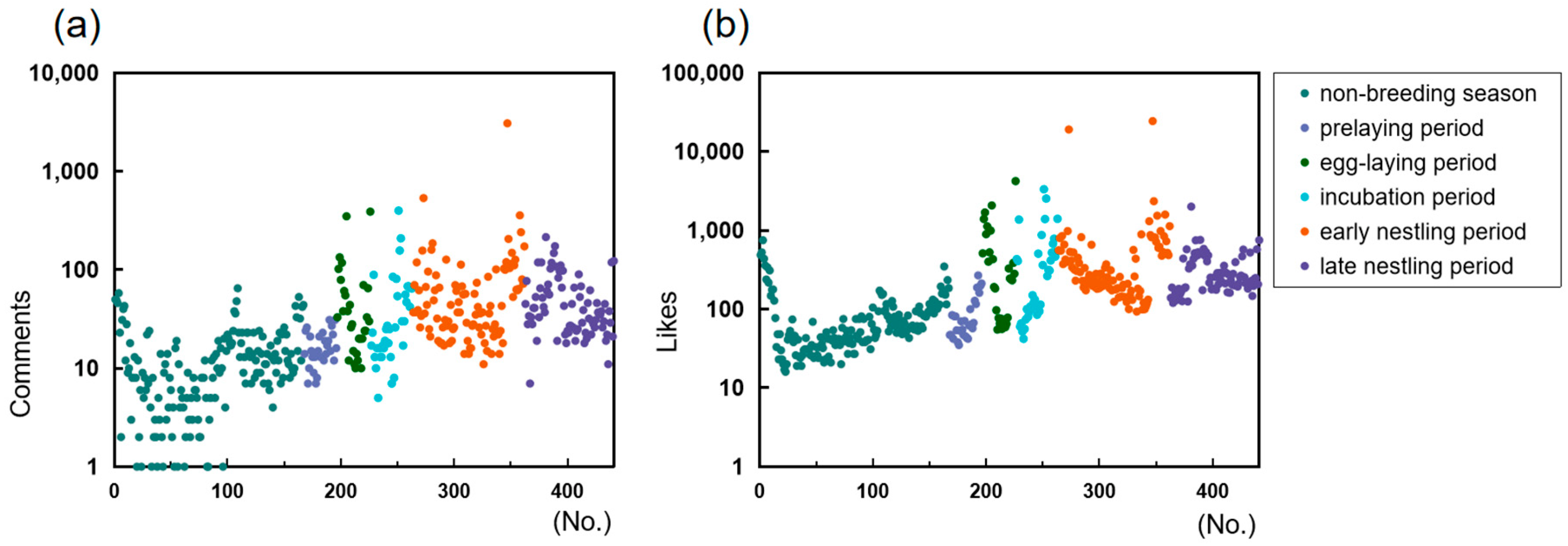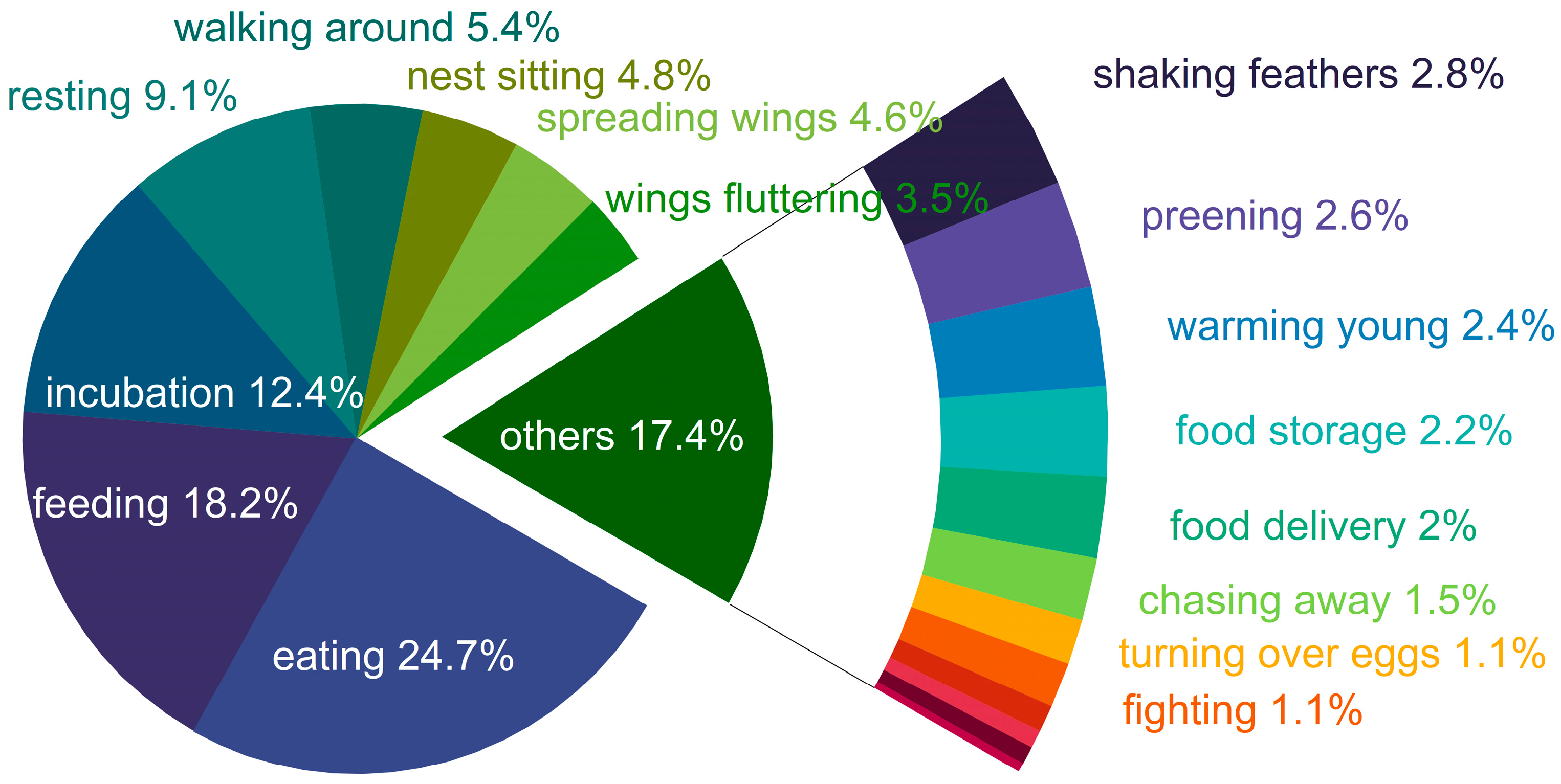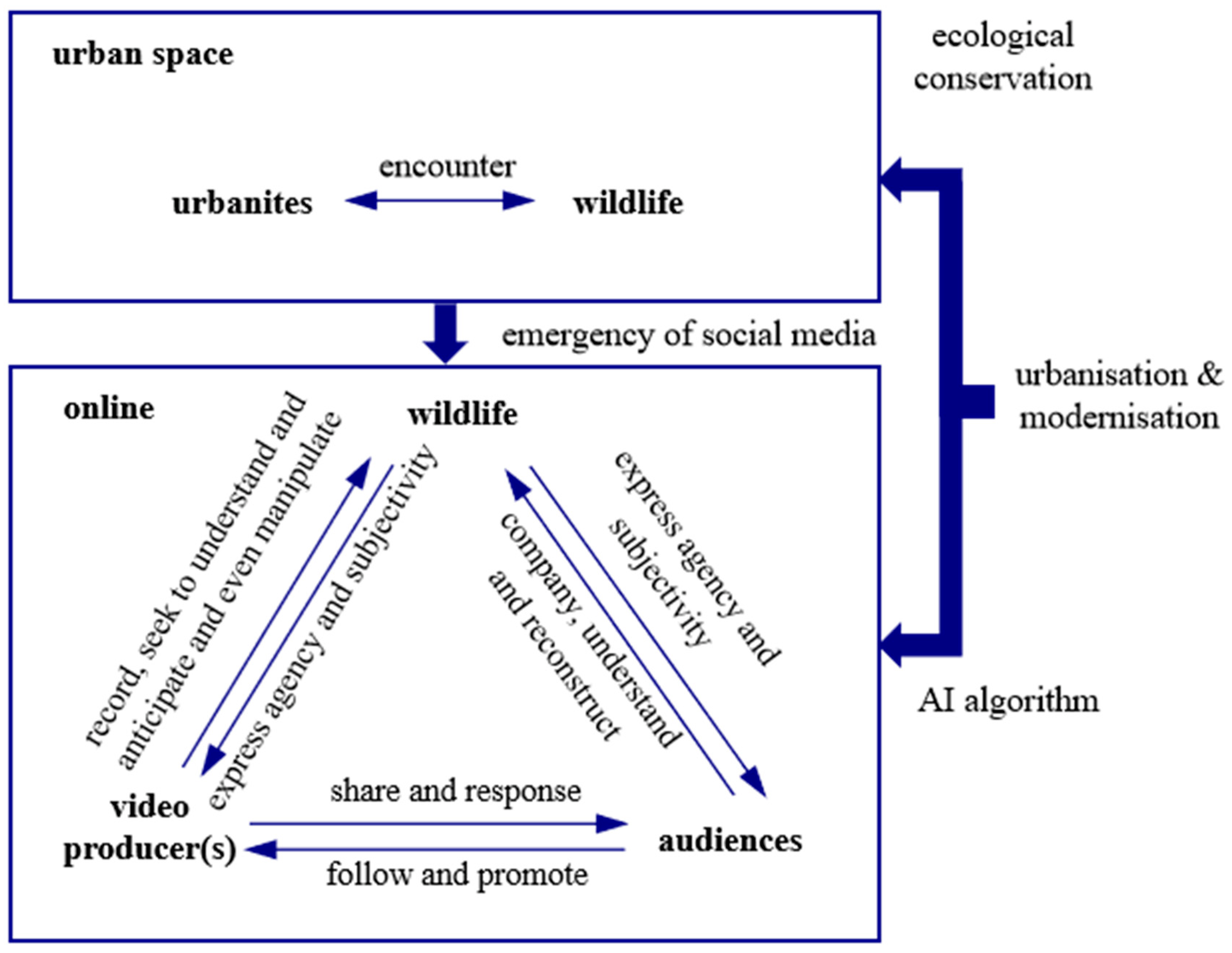TikTok’s Falco tinnunculus: Getting to Know Urban Wildlife through Social Media
Abstract
Simple Summary
Abstract
1. Introduction
2. Literature Review
3. Materials and Methods
4. Results
4.1. Knowledge Production of Urban Wildlife on TikTok
4.2. Users’ Perception of Urban Wildlife through TikTok
5. Discussion
6. Conclusions
Supplementary Materials
Author Contributions
Funding
Institutional Review Board Statement
Informed Consent Statement
Data Availability Statement
Conflicts of Interest
References
- Whatmore, S. Materialist returns: Practising cultural geography in and for a more-than-human world. Cult. Geogr. 2006, 13, 600–609. [Google Scholar] [CrossRef]
- Gabriel, N. Urban political ecology: Environmental imaginary, governance, and the non-human. Geogr. Compass 2014, 8, 38–48. [Google Scholar] [CrossRef]
- Jones, R.; Instone, L. Becoming-urban, becoming-forest: A historical geography of urban forest projects in Australia. Geogr. Res. 2016, 54, 433–445. [Google Scholar] [CrossRef]
- Heynen, N. Urban political ecology III: The feminist and queer century. Prog. Hum. Geogr. 2018, 42, 446–452. [Google Scholar] [CrossRef]
- Magle, S.B.; Hunt, V.M.; Vernon, M.; Crooks, K.R. Urban wildlife research: Past, present, and future. Biol. Conserv. 2012, 155, 23–32. [Google Scholar] [CrossRef]
- Capon, M.; Lysaniuk, B.; Godard, V.; Clauzel, C.; Simon, L. Characterizing the landscape compositions of urban wildlife encounters: The case of the stone marten (Martes foina), the red fox (Vulpes vulpes) and the hedgehog (Erinaceus europaeus) in the Greater Paris area. Urban Ecosyst. 2021, 24, 885–903. [Google Scholar] [CrossRef]
- Whittaker, D.; Vaske, J.J.; Manfredo, M.J. Specificity and the cognitive hierarchy: Value orientations and the acceptability of urban wildlife management actions. Soc. Nat. Resour. 2006, 19, 515–530. [Google Scholar] [CrossRef]
- Klump, B.C.; Martin, J.M.; Wild, S.; Hörsch, J.K.; Major, R.E.; Aplin, L.M. Innovation and geographic spread of a complex foraging culture in an urban parrot. Science 2021, 373, 456–460. [Google Scholar] [CrossRef]
- Carr, C.T.; Hayes, R.A. Social media: Defining, developing, and divining. Atl. J. Commun. 2015, 23, 46–65. [Google Scholar] [CrossRef]
- Hajli, M.N. A study of the impact of social media on consumers. Int. J. Mark. Res. 2014, 56, 387–404. [Google Scholar] [CrossRef]
- Byrum, K. “Hey friend, buy green”: Social media use to influence eco-purchasing involvement. Environ. Commun. 2019, 13, 209–221. [Google Scholar] [CrossRef]
- McLean, H.E.; Jaebker, L.M.; Anderson, A.M.; Teel, T.L.; Bright, A.D.; Shwiff, S.A.; Carlisle, K.M. Social media as a window into human-wildlife interactions and zoonotic disease risk: An examination of wild pig hunting videos on YouTube. Hum. Dimens. Wildl. 2022, 27, 307–320. [Google Scholar] [CrossRef]
- Bhatia, S.; Athreya, V.; Grenyer, R.; Macdonald, D.W. Understanding the role of representations of human–leopard conflict in Mumbai through media-content analysis. Conserv. Biol. 2013, 27, 588–594. [Google Scholar] [CrossRef]
- Gandiwa, E.; Sprangers, S.; van Bommel, S.; Heitkönig, I.M.; Leeuwis, C.; Prins, H.H. Spill-over effect in media framing: Representations of wildlife conservation in Zimbabwean and international media, 1989–2010. J. Nat. Conserv. 2014, 22, 413–423. [Google Scholar] [CrossRef]
- Dayer, A.A.; Williams, A.; Cosbar, E.; Racey, M. Blaming threatened species: Media portrayal of human–wildlife conflict. Oryx 2019, 53, 265–272. [Google Scholar] [CrossRef]
- Macdonald, D.W.; Jacobsen, K.S.; Burnham, D.; Johnson, P.J.; Loveridge, A.J. Cecil: A moment or a movement? Analysis of media coverage of the death of a lion, Panthera Leo. Animals 2016, 6, 26. [Google Scholar] [CrossRef]
- Folmer, A.; Haartsen, T.; Huigen, P.P. How ordinary wildlife makes local green places special. Landsc. Res. 2019, 44, 393–403. [Google Scholar] [CrossRef]
- Gore, M.L.; Siemer, W.F.; Shanahan, J.E.; Schuefele, D.; Decker, D.J. Effects on risk perception of media coverage of a black bear-related human fatality. Wildl. Soc. Bull. 2005, 33, 507–516. [Google Scholar] [CrossRef]
- Alexander, S.M.; Quinn, M.S. Coyote (Canis latrans) interactions with humans and pets reported in the Canadian print media (1995–2010). Hum. Dimens. Wildl. 2011, 16, 345–359. [Google Scholar] [CrossRef]
- Amiraslani, F.; Dragovich, D. Wildlife and newspaper reporting in Iran: A data analysis approach. Animals 2021, 11, 1487. [Google Scholar] [CrossRef]
- Barua, M. Whose issue? Representations of human-elephant conflict in Indian and international media. Sci. Commun. 2010, 32, 55–75. [Google Scholar] [CrossRef]
- Gundrum, F.A.; Sponarski, C.C.; Rickard, L.N.; De Urioste-Stone, S. Cognitions toward black bear hunting in Maine: A quantitative content analysis of the print news media surrounding hunting referendums. Hum. Dimens. Wildl. 2021, 26, 303–320. [Google Scholar] [CrossRef]
- Crown, C.A.; Doubleday, K.F. Man-eaters’ in the Media: Representation of Human-leopard Interactions in India Across Local, National, and International Media. Conserv. Soc. 2017, 15, 304–312. [Google Scholar] [CrossRef]
- Gore, M.L.; Knuth, B.A. Mass media effect on the operating environment of a wildlife-related risk-communication campaign. J. Wildl. Manag. 2009, 73, 1407–1413. [Google Scholar] [CrossRef]
- Sabatier, E.; Huveneers, C. Changes in media portrayal of human-wildlife conflict during successive fatal shark bites. Conserv. Soc. 2018, 16, 338–350. [Google Scholar] [CrossRef]
- Nanni, V.; Caprio, E.; Bombieri, G.; Schiaparelli, S.; Chiorri, C.; Mammola, S.; Pedrini, P.; Penteriani, V. Social media and large carnivores: Sharing biased news on attacks on humans. Front. Ecol. Evol. 2020, 8, 71. [Google Scholar] [CrossRef]
- Santos, B.S.; Crowder, L.B. Online news media coverage of sea turtles and their conservation. BioScience 2021, 71, 305–313. [Google Scholar] [CrossRef]
- Rebolo-Ifrán, N.; Grilli, M.G.; Lambertucci, S.A. Drones as a threat to wildlife: YouTube complements science in providing evidence about their effect. Environ. Conserv. 2019, 46, 205–210. [Google Scholar] [CrossRef]
- Fidino, M.; Herr, S.W.; Magle, S.B. Assessing online opinions of wildlife through social media. Hum. Dimens. Wildl. 2018, 23, 482–490. [Google Scholar] [CrossRef]
- Shaw, M.N.; Borrie, W.T.; McLeod, E.M.; Miller, K.K. Wildlife Photos on Social Media: A Quantitative Content Analysis of Conservation Organisations’ Instagram Images. Animals 2022, 12, 1787. [Google Scholar] [CrossRef]
- Gray, J.E. The geopolitics of “platforms”: The TikTok challenge. Internet Policy Rev. 2021, 10, 1–26. [Google Scholar] [CrossRef]
- Jia, L.; Liang, F. The globalization of TikTok: Strategies, governance and geopolitics. J. Digit. Media Policy 2021, 2, 273–292. [Google Scholar] [CrossRef]
- Stokel-Walker, C. TikTok’s global surge. New Sci. 2020, 245, 31. [Google Scholar] [CrossRef]
- Zhu, F. Why I Think Tik-Tok Would Be Dominant In The Future: Research on Company Background, Current Strategy & Future of Tik-Tok in China. Adv. Econ. Manag. Res. 2023, 4, 298. [Google Scholar] [CrossRef]
- Kumar, M.; Bhatia, R.; Rattan, D. A survey of Web crawlers for information retrieval. Wiley Interdiscip. Rev. Data Min. Knowl. Discov. 2017, 7, e1218. [Google Scholar] [CrossRef]
- Burns, G.L.; Howard, P. When wildlife tourism goes wrong: A case study of stakeholder and management issues regarding Dingoes on Fraser Island, Australia. Tour. Manag. 2003, 24, 699–712. [Google Scholar] [CrossRef]
- Wildlife Amendment Survey|22 Days, 100,000 Questionnaires, Talk about These Civil Society Voices. Available online: http://www.shanshui.org/information/1926/ (accessed on 15 March 2022).





Disclaimer/Publisher’s Note: The statements, opinions and data contained in all publications are solely those of the individual author(s) and contributor(s) and not of MDPI and/or the editor(s). MDPI and/or the editor(s) disclaim responsibility for any injury to people or property resulting from any ideas, methods, instructions or products referred to in the content. |
© 2023 by the authors. Licensee MDPI, Basel, Switzerland. This article is an open access article distributed under the terms and conditions of the Creative Commons Attribution (CC BY) license (https://creativecommons.org/licenses/by/4.0/).
Share and Cite
Yin, D.; Chen, J.; Gao, Q. TikTok’s Falco tinnunculus: Getting to Know Urban Wildlife through Social Media. Animals 2023, 13, 1292. https://doi.org/10.3390/ani13081292
Yin D, Chen J, Gao Q. TikTok’s Falco tinnunculus: Getting to Know Urban Wildlife through Social Media. Animals. 2023; 13(8):1292. https://doi.org/10.3390/ani13081292
Chicago/Turabian StyleYin, Duo, Jiachun Chen, and Quan Gao. 2023. "TikTok’s Falco tinnunculus: Getting to Know Urban Wildlife through Social Media" Animals 13, no. 8: 1292. https://doi.org/10.3390/ani13081292
APA StyleYin, D., Chen, J., & Gao, Q. (2023). TikTok’s Falco tinnunculus: Getting to Know Urban Wildlife through Social Media. Animals, 13(8), 1292. https://doi.org/10.3390/ani13081292





